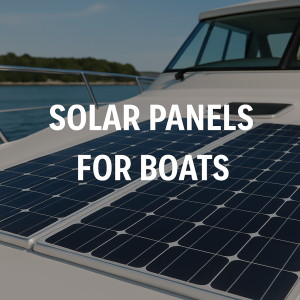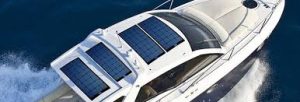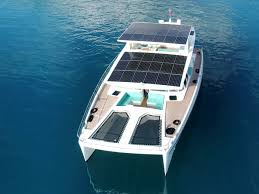Thinking of adding solar panels to your boat? Explore the pros, cons, and top marine solar brands in this expert 2025 guide to clean energy at sea.”
In the age of energy efficiency and sustainable cruising, solar power is no longer just a luxury—it’s fast becoming a necessity for boaters. Whether you’re a liveaboard sailor in the Mediterranean, a weekend angler in Ontario, or a long-range explorer preparing for an ocean crossing, marine solar panels offer a reliable, quiet, and clean source of power.
But how do you choose the right solar system for your boat? What are the trade-offs? And which brands are worth your investment?
This guide dives deep into the world of marine solar panels in 2025. We’ll unpack the latest tech developments, assess real-world pros and cons, share case studies, and review leading brands—all tailored to the unique needs of life on the water.
Why Solar Panels Matter in Modern Maritime Operations
As the maritime industry shifts toward decarbonization, solar energy has become a practical solution not only for large ships but also for private and commercial small craft. According to DNV’s Maritime Forecast to 2050, more than 40% of new leisure boats built in 2023–2024 included solar charging systems, up from just 18% in 2018.
For coastal and offshore cruisers, solar panels reduce reliance on noisy diesel generators or marina shore power. For remote anchorages or liveaboard vessels, solar means independence—a chance to power essential systems like refrigeration, navigation electronics, autopilot, or watermakers without running the engine.

How Marine Solar Works: A Primer
Key Components of a Boat Solar Setup
-
Solar Panels: Convert sunlight into DC electricity. Marine panels are often semi-flexible, waterproof, and UV-resistant.
-
Charge Controller: Regulates voltage and current going to the battery to prevent overcharging.
-
Battery Bank: Stores power for later use (AGM, lithium-ion, or flooded lead-acid types).
-
Inverter (optional): Converts DC to AC power for appliances like laptops, microwaves, or blenders.
Solar setups can be mounted on arch frames, biminis, cabins, or rails, depending on vessel design.
The Pros of Marine Solar Panels
1. Sustainable and Silent Power
No fumes, no noise, no fuel. Solar panels offer a clean alternative to combustion generators.
“For long-distance cruising yachts, solar has become a cornerstone of power independence,” — Royal Institution of Naval Architects, 2024
2. Reduced Fuel Dependency
Even on boats with engines, solar can keep batteries topped up, reducing fuel burn from engine alternators—especially important in tight fuel markets like the Pacific or Caribbean.
3. Long-Term Cost Savings
While upfront costs exist, solar panels often pay for themselves over a few seasons by cutting down marina charges, fuel, and battery replacements.
4. Low Maintenance
With no moving parts, quality solar panels require minimal upkeep—just occasional cleaning and routine inspections.
The Cons of Marine Solar Panels
1. Space and Shading Constraints
Limited flat space, sails, or radar arches can reduce exposure. Shade from rigging can drastically affect output, especially on monocrystalline panels.
2. Weather Dependency
While modern panels generate in overcast skies, output drops significantly in rain or high-latitude winter months. You’ll likely still need a backup source (alternator, wind, or generator).
3. Upfront Costs
Installing a full system—panels, controller, wiring, mounts—can range from $1,000 to $6,000 CAD depending on size and quality.
4. Installation Complexity
Incorrect wiring, cheap controllers, or improper panel placement can reduce effectiveness. DIY is possible, but many opt for professional help.
What to Look for in a Marine Solar Panel (2025 Edition)
Key Features and Considerations
1. Panel Type
-
Monocrystalline: High efficiency (~20–23%), ideal for limited space. Performs well in low light.
-
Polycrystalline: Lower cost, less efficient (~15–18%), and slightly bulkier.
-
Thin Film / Flexible: Lightweight and adaptable to curved surfaces, but often less durable and less efficient.
2. Efficiency Ratings
Look for panels with ≥20% efficiency. For example, SunPower Maxeon cells are market leaders in real-world performance.
3. Voltage Output
Match your system—most marine batteries are 12V, but 24V setups exist for larger boats. Panels rated 18–22V are typical for 12V charging.
4. Build Quality
-
UV-resistant coatings
-
Corrosion-proof aluminum frames
-
Encapsulated junction boxes
Marine-grade panels must endure salt, humidity, vibration, and sun 24/7.
5. Warranty & Manufacturer Support
Top-tier panels come with 5–10 year performance warranties and solid customer service—especially critical for global cruisers.
Top Marine Solar Brands in 2025
1. SunPower
🔗 Official Product Page | Retailer (Blue Marine)
-
Type: Rigid / semi-flexible
-
Strengths: Industry-leading efficiency (~23%), premium materials, 25-year warranty 114.
-
Applications: Bluewater cruisers, yachts, offshore boats.
-
Notable Product: SunPower 110W Flexible Panel.
2. Renogy
-
Type: Rigid, flexible, and kits.
-
Strengths: Affordable, DIY-friendly, includes controllers/wiring, IP67 waterproof rating 113.
-
Applications: Sailboats, powerboats, budget cruisers.
-
Notable Product: Renogy 200W Solar Starter Kit.
3. Solbian
🔗 Brand Overview (via BoatTest)
-
Type: Flexible, high-end Italian panels.
-
Strengths: Ultra-lightweight (2.5 kg/m²), customizable shapes, SunPower cell technology 1.
-
Applications: Racing yachts, performance cruisers.
-
Notable Product: Solbian SP Series (marine-grade top-tier).
4. Victron Energy
🔗 Official Marine Solutions Page
-
Type: Panels + charge controllers.
-
Strengths: Smart MPPT tech, seamless integration with marine electrical systems, optimal shading tolerance 5.
-
Applications: Integrated smart marine systems.
-
Notable Product: Victron BlueSolar 100/30 MPPT Controller.
5. Go Power!
-
Type: Panels + complete kits.
-
Strengths: Aerodynamic designs, PWM/MPPT controllers included, North American support 12.
-
Applications: Cabin cruisers, small powerboats.
-
Notable Product: Go Power! 190W Marine Solar Kit.
Real-World Applications and Stories
Case Study: Offshore Liveaboard in Australia
Ian and Lisa, cruising along the Queensland coast on their 42-ft cutter, installed a 400W Solbian flexible array with a Victron controller in 2022.
“We haven’t plugged into shore power in over a year,” says Ian. “Even on cloudy days, we top up our lithium bank enough to run the fridge, navigation system, and lights.”
Case Study: Weekend Sailor in Canada
Linda, a solo sailor on Lake Huron, chose a Renogy 100W panel for her 26-ft sloop.
“It’s basic but enough to keep my phone, VHF, and nav lights running for weekend trips without starting the engine.”
Challenges and Smart Solutions
Challenge 1 – Panel Positioning
Solution: Use adjustable rail mounts or tilting systems to track the sun and avoid shade from rigging.
Challenge 2 – Overcharging or Undercharging
Solution: Use a MPPT (Maximum Power Point Tracking) charge controller, which adjusts input voltage for optimal performance (30% more efficient than PWM controllers).
Challenge 3 – Battery Compatibility
Solution: Confirm your charge controller and solar output match your battery type (AGM, flooded, or LiFePO4). Brands like Victron and Morningstar offer lithium-ready controllers.
Future Outlook: Where Marine Solar Is Headed
In the next 5 years, we’ll likely see:
-
Integrated solar decks: Panels built into walkable surfaces.
-
Smart solar systems: Bluetooth-connected controllers and app dashboards for real-time performance monitoring.
-
Hybrid power packages: Solar paired with hydrogenerators and wind turbines in modular systems.
-
Lightweight bifacial panels: Capture sunlight on both sides, increasing power output by up to 20%.
These developments are being actively tested on eco-racing yachts, IMO decarbonization pilot vessels, and long-range expeditions backed by the Cruising Club of America and IYRA.
FAQ: Solar Panels for Boats
1. How much solar power do I need for my boat?
Depends on usage. Weekend sailors may get by with 100–200W. Liveaboards typically need 400–800W for refrigeration, lighting, and navigation.
2. Do I need an MPPT controller?
Yes—especially for systems over 100W or in variable sunlight. MPPT controllers improve efficiency by up to 30% over basic PWM controllers.
3. Can I walk on marine solar panels?
Only if designed for it. Solbian and some Go Power! panels are semi-flexible and walkable. Never walk on rigid glass panels.
4. Will solar charge my engine battery too?
Yes, with a dual-bank controller or battery isolator, you can charge both house and start batteries.
5. Are marine panels different from RV panels?
Yes—marine panels must withstand salt, UV, and constant motion. Always choose marine-grade for durability and safety.
6. Can I install solar myself?
Yes, especially with kits from Renogy or Go Power! But for larger setups, consult a marine electrician to avoid grounding issues.
7. What happens on cloudy days?
Modern panels still produce ~10–25% output in cloudy conditions. Lithium battery banks help buffer shortfalls.
Conclusion: Sailing Toward a Sun-Powered Future
Solar panels have transformed how boaters generate and manage power at sea. From quiet anchorages to demanding offshore routes, solar offers energy freedom, cost savings, and reduced environmental impact.
Choosing the right system depends on your needs, your boat’s layout, and your cruising plans. But whether you’re outfitting a coastal weekender or a global cruiser, a well-designed marine solar setup will pay dividends in reliability and peace of mind.
Ready to go solar? Start by assessing your energy needs, measuring mounting space, and researching brands like SunPower, Solbian, or Victron. The sun’s out there—why not let it power your journey?
References
-
DNV. (2024). Maritime Forecast to 2050 – Energy Transition Outlook. https://www.dnv.com
-
Royal Institution of Naval Architects. (2024). Marine Renewable Energy Applications. https://www.rina.org.uk
-
Victron Energy. (2025). MPPT Charge Controller Specifications. https://www.victronenergy.com
-
SunPower. (2025). Marine Solar Product Data Sheets. https://us.sunpower.com
-
Renogy. (2025). Marine Solar Panel Kits. https://www.renogy.com
-
Solbian Solar. (2024). Lightweight Marine Panels. https://www.solbian.eu
-
Transport Canada. (2023). Marine Power and Energy Efficiency Guidelines. https://tc.canada.ca
-
IYRA (International Yacht Racing Association). (2024). Sustainable Yachting Initiatives. https://www.iyra.org






An interesting article .